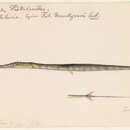Diagnostic Description
provided by Fishbase
Color in life brownish above, lighter below, with a series of pale blue spots from head to dorsal fin on midline of back, row of blue spots lateral to the mid-dorsal row and two lateral rows of blue spots on snout. First four vertebrae fused (Ref. 9826). Middle caudal rays extended as a long filament; no scales or fin spines. No barbel at tip of lower jaw (Ref. 26938)
Morphology
provided by Fishbase
Dorsal spines (total): 0; Dorsal soft rays (total): 14 - 16; Analspines: 0; Analsoft rays: 14 - 16; Vertebrae: 87
Trophic Strategy
provided by Fishbase
A solitary species (Ref. 26340) occurs over grass flats and reefs, and on hard and rocky bottoms (Ref. 5377). Feeds on fishes, small crustaceans (Ref. 6557) or invertebrates.
Biology
provided by Fishbase
A solitary species (Ref. 26340) occurs over grass flats and reefs, and on hard and rocky bottoms (Ref. 5377). Feeds on fishes, small crustaceans (Ref. 6557) or invertebrates.
Importance
provided by Fishbase
fisheries: minor commercial; price category: unknown; price reliability:
Fistularia tabacaria
provided by wikipedia EN
Fistularia tabacaria, the cornetfish, blue-spotted cornetfish, tobacco trumpetfish or unarmed trumpetfish,[2] is a species of cornetfish found along the Atlantic coasts of the Americas and in the central Atlantic off West Africa and the Macaronesian Islands.[3][1] This species is of minor importance in commercial fisheries.[2]
Description
This species grows to 200 cm (79 in) in total length, though most only reach 120 cm (47 in).[2] The cornetfish is easily mistaken for the needlefish; the defining characteristic that separates the two is the cornetfish's smaller mouth and jaws with an elongated face in comparison to the needlefish's elongated jaw and mouth. The cornetfish is greenish-brown dorsally with overall pale blue spots and lines.
Biology
Fistularia tabacaria is most frequently recorded in and over seagrass beds and coral reefs, although it also occurs over hard, rocky substrates. It is usually a solitary species that is very rarely seen in groups. It feeds mainly on small crustaceans and small fish.[1]
It is an important component in the diet of the Atlantic bluefin tuna (Thunnus thynnus).[1]
References

- license
- cc-by-sa-3.0
- copyright
- Wikipedia authors and editors
Fistularia tabacaria: Brief Summary
provided by wikipedia EN
Fistularia tabacaria, the cornetfish, blue-spotted cornetfish, tobacco trumpetfish or unarmed trumpetfish, is a species of cornetfish found along the Atlantic coasts of the Americas and in the central Atlantic off West Africa and the Macaronesian Islands. This species is of minor importance in commercial fisheries.
- license
- cc-by-sa-3.0
- copyright
- Wikipedia authors and editors
Diet
provided by World Register of Marine Species
Feeds on fishes, small crustaceans and invertebrates
North-West Atlantic Ocean species (NWARMS)
- license
- cc-by-4.0
- copyright
- WoRMS Editorial Board
Distribution
provided by World Register of Marine Species
Georges Bank and southern Canada to Bermuda and Brazil
North-West Atlantic Ocean species (NWARMS)
- license
- cc-by-4.0
- copyright
- WoRMS Editorial Board
Habitat
provided by World Register of Marine Species
Found to depths of 200 m, over grass flats and reefs.
North-West Atlantic Ocean species (NWARMS)
- license
- cc-by-4.0
- copyright
- WoRMS Editorial Board
Habitat
provided by World Register of Marine Species
nektonic
North-West Atlantic Ocean species (NWARMS)
- license
- cc-by-4.0
- copyright
- WoRMS Editorial Board

